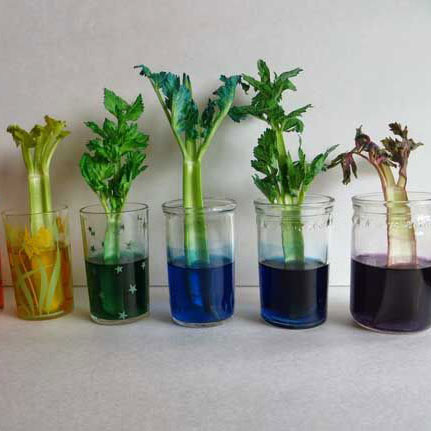 Image from PBS Kids for Parents.
Image from PBS Kids for Parents.
How do plants "drink" water?
- Easy
- Not Messy
- 15 Minutes
- Indoor
Do plants drink water?
You may know that you have to water plants to keep them alive, but how do plants get water from the soil into the parts they need? Try this experiment to learn how!
You Will Need
5 or 6 plant cuttings, such as celery stalks, romaine lettuce leaves, white carnations, daisies, or Queen Anne’s Lace
One different color of food coloring for each plant
One jar or cup for each plant
Water
Scissors
Directions
- Carefully trim off the bottom end (not with the flower) of the plants you plan to use.
- Fill the cups or jars about halfway with water. Add 5 or 6 drops of food coloring until you achieve your desired color.
- Place a plant into each jar. Have your children guess what they think will happen as the plants sit in the colored water.
How it works
Plants drink water through a process called osmosis. Osmosis is the movement of a liquid into a living thing, creating a balance of that liquid. For example, if a plant needs water it will use osmosis to pull water through the roots until it has enough water to photosynthesize, or make food.
The plants take the water up to the top of the plant through capillary action. Water sticks to itself and climbs up and down the plant through tubes called the xylem and phloem, which are similar to our veins. The plant will draw the colored water up and some of the color molecules will stay in the upper parts of the plant, coloring the top of the stalks or flowers!
Key Words
- Adhesion
- The property of sticking together, such as how the surface of a water molecule wants to stick to another water molecule.
- Capillary Action
- Due to forces such as adhesion, cohesion, and surface tension, liquids such as water, move up a solid. Plants use this process to move water and nutrients up and down their stalks in tubes called xylems and phloems.
- Cohesion
- A force between two molecules that holds them together.
- Molecule
- The smallest unit of a substance that has all the properties of that substance. For example, a water molecule is the smallest unit that can still be considered water.
- Osmosis
- The movement of a liquid through a membrane to balance the amounts on both sides of the membrane. It is a passive process, meaning it does not take energy to happen.
- Photosynthesis
- The process plants use to make their own food, using sunlight, water, and carbon dioxide.
- Phloem
- Tiny tubes in plant tissue that carry food from the leaves down to the other parts of a plant.
- Surface Tension
- A force on the surface of a liquid that causes it to act like an elastic sheet. For example, surface tension on water allows some insects to walk on top of it.
- Vascular Plants
- Plants that have specialized tissues (xylem and phloem) that help move water and nutrients throughout the plants.
- Xylem
- Tiny tubes in vascular plants that helps provide support to the plant as well as bringing water and nutrients from the roots to the upper parts of the plants.
